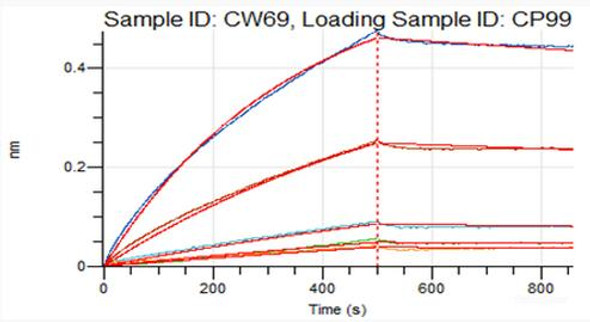Description
| Product Name: | Recombinant Cynomolgus Fc gamma RIIIA/FCGR3A/CD16a (C-6His) |
| Product Code: | RPES6771 |
| Size: | 10µg |
| Species: | Cynomolgus macaques |
| Expression Host: | HEK293 Cells |
| Synonyms: | Low Affinity Immunoglobulin Gamma Fc Region Receptor III-A, CD16a Antigen, Fc-Gamma RIII-Alpha, Fc-Gamma RIII, Fc-gamma RIIIa, FcRIII, FcRIIIa, FcR-10, IgG Fc Receptor III-2, CD16a, FCGR3A, CD16A, FCG3, FCGR3, IGFR3 |
| Mol Mass: | 22 kDa |
| AP Mol Mass: | 30-40 kDa |
| Tag: | C-6His |
| Purity: | > 95 % as determined by reducing SDS-PAGE. |
| Endotoxin Level: | < 1.0 EU per μg of the protein as determined by the LAL method. |
| Bio Activity: | Testing in progress |
| Sequence: | Glu21-Gly206 |
| Accession: | A0A140HDP8 |
| Storage: | Generally, lyophilized proteins are stable for up to 12 months when stored at -20 to -80°C. Reconstituted protein solution can be stored at 4-8°C for 2-7 days. Aliquots of reconstituted samples are stable at < -20°C for 3 months. |
| Shipping: | This product is provided as lyophilized powder which is shipped with ice packs. |
| Formulation: | Lyophilized from a 0.2 μm filtered solution of PBS, pH 7.4. Normally 5 % - 8 % trehalose, mannitol and 0.01% Tween80 are added as protectants before lyophilization. Please refer to the specific buffer information in the printed manual. |
| Reconstitution: | Please refer to the printed manual for detailed information. |
| Background: | Receptors for the Fc region of immunoglobin G (FcγR) are divided into three classes and FcγRIII is a multifunctional, low/intermediate affinity receptor. In humans, FcγRIII is expressed as two distinct forms (FcγRIIIA and FcγRIIIB) that are encoded by two different but highly homologous genes in a cell type-specific manner. FcγRIIIB is a low-affinity, GPI-linked receptor expressed by neutrophils and eosinophils, whereas FcγRIIIA is an intermediate affinity polypeptide-anchored transmembrane glycoprotein expressed by a subset of T lymphocytes, natural killer (NK) cells, monocytes, and macrophages. The FcγRIIIA receptor is involved in phagocytosis, secretion of enzymes, inflammatory mediators, antibody-dependent cellular cytotoxicity (ADCC), mast cell degranulation, and clearance of immune complexes. FcγRIIIA has an immunoreceptor tyrosine-based activation motif (ITAM) in its cytoplasmic domain and delivers an activation signal in the immune responses. Aberrant expression or mutations in this gene is implicated in susceptibility to recurrent viral infections, systemic lupus erythematosus, and alloimmune neonatal neutropenia. In humans, it is a 50 -70 kD type I transmembrane activating receptor. The FcγRIIIA cDNA encodes 254 amino acid including a 16aa signal sequence, 191 amino acid ECD with two C2-type Ig-like domains, five potential N-glycosylation sites, a 22 amino acid transmembrane sequence and a 25 amino acid cytoplasmic domain. |






